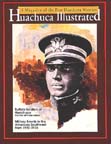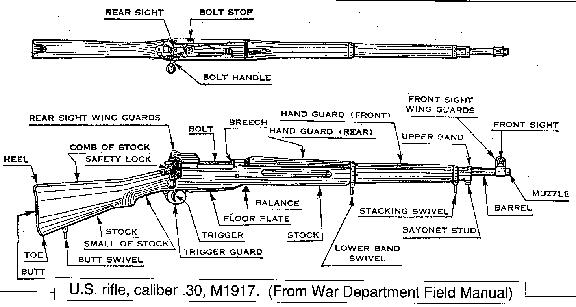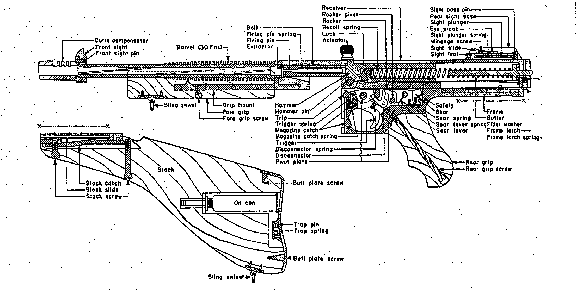 Weapons: 1910-1939
Weapons: 1910-1939The War with Spain in 1898 revealed deficiencies in weaponry and a lag in technology which the Army sought to correct in the ensuing years. The Krag-Jorgenson rifle, which had been adopted in 1892, was made obsolete by high-velocity, low-trajectory, clip-loading rifles which were capable of firing at a sustained high rate. The Krag-Jorgenson was replaced by the 1903 Springfield rifle which incorporated the latest innovations.

U.S. rifle, caliber.30, M1903. (From War Department
Field Manual)
The M1903 Springfield was a .30 caliber bolt-action, magazine-fed rifle. The Spanish-American War made clear the necessity for the ability to deliver a high rate, sustained fire in the urgency to gain fire superiority. In 1900 the Ordnance Department recommended the adoption of a new arm based on the Mauser system. Manufacturing rights for this bolt action mechanism were purchased from the German Mauser patent owners for $200,000.
 The Springfield rifle became the stalwart individual weapon for both
infantryman and cavalry trooper. There was no carbine model for this rifle.
After the introduction of the M-1 rifle just before World War II the Springfield
remained in service until it could be replaced and even then saw action
as a sniper rifle. It was beloved for its reliability and accuracy and remained
in some National Guard units beyond the Korean War.
The Springfield rifle became the stalwart individual weapon for both
infantryman and cavalry trooper. There was no carbine model for this rifle.
After the introduction of the M-1 rifle just before World War II the Springfield
remained in service until it could be replaced and even then saw action
as a sniper rifle. It was beloved for its reliability and accuracy and remained
in some National Guard units beyond the Korean War.
To supplement the stocks of the M1903 Springfield, the M1917 Enfield rifle was adopted in that year. It was the .303 P-14 that was made in the U.S. for Great Britain, but it was converted to .30 caliber.
Firing rifle from horseback. (From War Department Field Manual)
The most important development in weapons technology was the machine gun. It was responsible for 20th century tactics. Although the Army had employed manually operated Gatling guns in the Indian Wars and in the Spanish-American War, it wasn't until American inventors such as Hiram Maxim, John Browning and Isaac N. Lewis developed automatic machine guns that its impact was realized. Their designs became models for machine guns in all major armies. A Machine Gun Troop was added to the cavalry regiment which packed tripod, ammo box, and barrel on horses.
The M1918 Browning Automatic Rifle or BAR was a machine gun as well as a rifle and used in both World Wars. It was gas-operated, .30 caliber, air-cooled, magazine-fed, and fully or semiautomatic. It could be fired from the shoulder or, when used with a shoulder sling, fired from the waist. Stocks left over from World War I were used until loans to the British and new requirements necessitated the production of 168,000 BARs in 1943. These were only slightly changed from the 1918 design.

U.S. rifle, caliber.30, M1917. (From War Department
Field Manual)
The M1928A1 .45 caliber Thompson submachine gun could be fired as a semi-automatic or fully automatic by switching a selector on the left side of the receiver. It was fed with a 50-round drum magazine or 20 to 30-round box magazine. Designed by Brig. Gen. John T. Thompson of the Ordnance Department, the gun became standardized in 1938 as the .45 M1928A1. It was used by the British, French, Canadian and American soldiers during World War II. Heavy and expensive to produce, the Thompson was replaced by first the M2 and then the M3 submachine gun.

Cross-section of Thompson submachine gun, caliber
.45, M1928A1. (From War Department Field Manual)
Designed by John Browning, the M1917A1 Browning .30 caliber heavy machine
gun was watercooled, belt-fed and recoil operated. After an impressive demonstration
of the weapon's capabilities by Browning himself, the Army adopted it in
1917 and with a slight modification, it was the standard ground gun until
after World War II. It fires 450 to 600 rounds per minute at a muzzle velocity
of 2,800 feet-per-second, and weighs 93 pounds with tripod and water-filled
jacket. Its effective range was 1,800 yards. The M1917 Browning heavy machine
gun was one of the standard World War I weapons that was carried over to
World War II and beyond. It was given new designations as it changed from
water-cooled (M1917A1) to air-cooled (M1919A4). The .50 caliber Browning
 machine gun was redesigned in 1933 so that it could be mounted on tanks
and aircraft or converted to antiaircraft use. Both Browning machine guns
were world renowned. The .50 caliber aircraft gun performed unfailingly
in cold or hot climate and contributed greatly to allied air victories.
machine gun was redesigned in 1933 so that it could be mounted on tanks
and aircraft or converted to antiaircraft use. Both Browning machine guns
were world renowned. The .50 caliber aircraft gun performed unfailingly
in cold or hot climate and contributed greatly to allied air victories.
The M1917 machine gun with tripod. (From War Department Field Manual)
The M1905 3-inch field gun was one of the models that accompanied American forces into Mexico in 1916 on the Punitive Expedition. The gun was patterned after the famous French 75mm of 1897 and remained in use throughout the 1920s. Common shrapnel, high explosive shrapnel, or steel shells were used as ammunition. It had a muzzle velocity of 1,700 feet per second and a maximum range of 8,500 yards. There were only 340 of these guns made.
The old rod bayonet had demonstrated in the 1898 campaign that it was too flimsy. It was replaced in 1905 with a knife bayonet which was sixteen inches long and weighed one pound.
 Soldier in the "Guard" position with
M1905 bayonet. (From War Department Field Manual)
Soldier in the "Guard" position with
M1905 bayonet. (From War Department Field Manual)
The M1911 Colt .45 automatic pistol supplanted the .38 caliber revolver which had shown itself incapable of stopping a charging Moro warrior in the Philippines.
 Left side of pistol, M1911.
Left side of pistol, M1911.
(From War Department Field Manual)
The M1917.45 caliber Smith and Wesson revolver was modified to accept the .45 cartridge used by the M1911 Automatic and produced to meet the wartime demands of the Army which ordered 153,000 of them. Many of the weapons survived into World War II. Another 150,000 modified versions of the M1897 were also purchased and became known as the M1917.45 caliber Colt New Service revolvers
 Left side of pistol, Ml911Al.
Left side of pistol, Ml911Al.
(From War Department Field Manual)
Called the "Patton" saber after its designer George S. Patton, the M1913 cavalry sword is intended to be used as a thrusting weapon rather than a slashing saber. The saber and a webbed khaki scabbard are attached to the cavalryman's saddle. They were not worn with the uniform. It was discontinued as a Cavalry weapon in 1934.

The M1911 pistol, showing parts.
(From War Department Field Manual)


Colt revolver, caliber .45, M1917
--------------------------------------Smith and Wesson revolver, caliber.45, M1917.
(From War Department Field Manual)----------------------------------------- (From War Department Field Manual)

The lunging move with Patton saber. (From War Department
Field Manual)